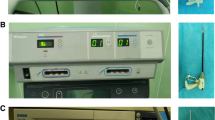Abstract
Background
An electrothermal bipolar vessel sealer (EBVS; Ligasure, Valleylab, Boulder, CO, USA) was developed as an alternative to suture ligatures, hemoclips, staplers, and ultrasonic coagulators for ligating vessels and tissue bundles. The EBVS seals vessels up to 7 mm in diameter by denaturing collagen and elastin within the vessel wall and surrounding connective tissue. This study is the first to determine the clinical efficacy and safety of this instrument and delineate its potential timesavings in both experimental (animal) and clinical scenarios.
Methods
A prospective review of the author’s clinical experience with the EBVS in laparoscopic and open operations from October 1998 to March 2000 was performed. In addition, five Yorkshire domestic pigs underwent 150-cm small intestine resections (n=10) using the EBVS (n=5) and suture ligatures (n=5). Measurements included time to complete intestinal resection, the number of applications per minute for each method, and the presence of postapplication bleeding. Statistical analysis was performed using Student’s t-test.
Results
The EBVS was used in 98 cases (46 laparoscopic and 52 open) with a mean of 43 applications (range, 10–150 applications) per case. The operations included 53 colon and/or small bowel resections (54.1%), 24 fundoplications (24.5%), 12 gastric resections (12.2%), 3 splenectomies, 2 pancreatectomies, 1 adrenalectomy, 1 bilateral salpingooopherectomy, 1 pancreatic cyst-jejunostomy, and 1 vagotomy with gastrojejunostomy. In all these cases, the EBVS was intended to be the only means of vessel ligation. An alternative ligation technique was required for bleeding in only 13 (0.3%) of more than 4,200 applications of the EBVS. No postoperative hemorrhagic complications occurred. There was an estimated mean reduction in operative time of 39 min per open procedure, and a mean prolongation in operative time of 8 min per laparoscopic procedure when the EBVS was used in lieu of suture ligatures, hemoclips, staplers, or ultrasonic coagulators. In the animal model, the mean time for completion of the intestinal resection was 251.9 s for the EBVS and 702.0 s for ligatures (p<0.001). The mean number of applications per minute was 7.6 for the EBVS and 1.8 for ligatures (p<0.001). No postapplication bleeding was seen.
Conclusions
Initial clinical results from the use of EBVS in laparoscopic and open procedures demonstrate it to be safe and effective, reducing operative time in open procedures. Suture ligatures, ties, hemoclips, and other ligating techniques were used rarely (0.3%) after an application of the EBVS. In an experimental animal model, the EBVS was significantly faster and more efficient (more applications per minute) than ligatures for intestinal resection.
Similar content being viewed by others
References
Hoenig DM, Chrostek CA, Amaral JF (1996) Laparoscopic coagulating shears: alternative methods of hemostatic control of unsupported tissue. J Endourol 10: 431–433
Kennedy JS, Stranahan PL, Taylor KD, Chandler JG (1998) High-burst-strength, feedback-controlled bipolar vessel sealing. Surg Endosc 12: 876–878
Klioze SD, Poppaas DP, Rooke CT, Choma TJ, Schlossberg SM (1994) Development and initial application of a real-time thermal control system for laser tissue welding. J Urol 152: 744–748
Spivak H, Richardson WS, Hunter JG (1998) The use of bipolar cautery, laparoscopic coagulating shears, and vascular clips for hemostasis of small and medium-sized vessels. Surg Endosc 12: 183–185
Author information
Authors and Affiliations
Additional information
Oline publication: 14 May 2001
Rights and permissions
About this article
Cite this article
Heniford, B.T., Matthews, B.D., Sing, R.F. et al. Initial results with an electrothermal bipolar vessel sealer. Surg Endosc 15, 799–801 (2001). https://doi.org/10.1007/s004640080025
Received:
Accepted:
Issue Date:
DOI: https://doi.org/10.1007/s004640080025




